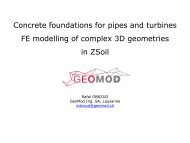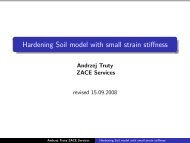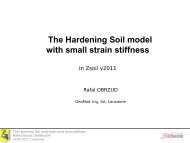3D Numerical Analysis of A Building Under Construction Collapse in ...
3D Numerical Analysis of A Building Under Construction Collapse in ...
3D Numerical Analysis of A Building Under Construction Collapse in ...
Create successful ePaper yourself
Turn your PDF publications into a flip-book with our unique Google optimized e-Paper software.
SYMPOSIUM : NUMERICS IN GEOTECHNICS & STRUCTURES<br />
25 YEARS ZSOIL.PC<br />
DATE :30-31.08.2010<br />
Better ZSOIL,<br />
Better Geotechnical <strong>Analysis</strong><br />
——<strong>3D</strong> <strong>Numerical</strong> <strong>Analysis</strong> <strong>of</strong> A <strong>Build<strong>in</strong>g</strong> <strong>Under</strong><br />
<strong>Construction</strong> <strong>Collapse</strong> <strong>in</strong> Shanghai<br />
YIN JI 1,2<br />
Email:ge<strong>of</strong>em@126.com<br />
1.Shanghai Geotechnical Investigation & Design, co,.ltd.<br />
2.GEOFEM
CONTENTS<br />
• Overview<br />
• Model<strong>in</strong>g<br />
• Results<br />
• Outlook
Overview<br />
Some photos<br />
• On June 27, 2009 at 5:30am<br />
local time, Block 7, one <strong>of</strong> the<br />
eleven 13-storey build<strong>in</strong>gs <strong>of</strong><br />
the apartment complex,<br />
collapsed kill<strong>in</strong>g one worker.<br />
• As can be seen <strong>in</strong> the photo,<br />
the 13-story apartment build<strong>in</strong>g<br />
collapsed with just enough<br />
room to escape what would<br />
have been a far more<br />
destructive dom<strong>in</strong>o effect<br />
<strong>in</strong>volv<strong>in</strong>g other structures <strong>in</strong> the<br />
11-build<strong>in</strong>g complex.
Overview<br />
Cause<br />
Garage<br />
excavation<br />
N<br />
N<br />
First<br />
surcharge<br />
第 一 次 堆 土<br />
第 二 次 堆 土<br />
Second<br />
surcharge<br />
• The surcharge (backfill from underground garage excavation) on the north<br />
side <strong>of</strong> the build<strong>in</strong>g is considered the chief culprit<br />
• And the underground garage excavation on the south side <strong>of</strong> the build<strong>in</strong>g is<br />
another important cause<br />
• Other unfavorable factors : heavy ra<strong>in</strong> just several hours before the accident
Overview<br />
Layout <strong>of</strong> foundation<br />
• The foundation style <strong>of</strong> the build<strong>in</strong>g is “Pile + Strip Foundation”, no raft<br />
• About 118 Pre-stressed concrete pipe piles are used to support the build<strong>in</strong>g<br />
• Pile type is PHC-AB-400-80-33(accord<strong>in</strong>g to shanghai design code),<br />
Dia.=400mm,thickness=80mm, length=33m (11m+11m+11m, 2 welded<br />
jo<strong>in</strong>ts)
Overview<br />
Bear<strong>in</strong>g capacity <strong>of</strong> pile<br />
• Bear<strong>in</strong>g capacity <strong>of</strong> the PHC<br />
pile is described <strong>in</strong> this<br />
Scheme ( accord<strong>in</strong>g to<br />
DBJT08-92-2000, Shanghai<br />
Design Standards)<br />
• Flexural capacity is coupled<br />
with the axial force<br />
• For a pile at work (axial<br />
force 500kN~1500kN), its<br />
max. flexural capacity will be<br />
around 150kNm<br />
• Jo<strong>in</strong>ts are weak l<strong>in</strong>k. Their<br />
flexural capacity will be<br />
lower than 150kNm, if<br />
weld<strong>in</strong>g quality is not reliable
Overview<br />
Borehole<br />
Pile<br />
Wmax=67.9%,e0=1.90,fa
Overview<br />
Soil and Pile<br />
2m<br />
11m<br />
Pile – pile<br />
welded jo<strong>in</strong>t<br />
Pile-strip<br />
foundation<br />
jo<strong>in</strong>t<br />
Very s<strong>of</strong>t clay<br />
Bad lateral support<br />
Stiffer soil<br />
boundary<br />
Good lateral support<br />
• The stiffness difference <strong>of</strong> the<br />
upper soil and lower soil is<br />
very huge. If we use CPT as<br />
the basis for judgment <strong>of</strong> soil<br />
stiffness, the lower soil is<br />
about 8 (2.5/0.35Mpa) times<br />
large than the upper soil.<br />
• The large stiffness difference<br />
will cause large shear force<br />
and moment <strong>of</strong> piles near the<br />
boundary.<br />
• The pile – pile welded jo<strong>in</strong>t<br />
(weak l<strong>in</strong>k) just situates near<br />
the boundary.<br />
• The pile – strip foundation jo<strong>in</strong>t<br />
is also <strong>in</strong> the very s<strong>of</strong>t clay.
Overview<br />
Schematic diagram<br />
North<br />
+37.60<br />
Excavation <strong>of</strong><br />
<strong>Under</strong>ground garage<br />
Depth=4.9m<br />
BLD. No.7#,13F<br />
+4.70m<br />
4900<br />
Soil nail<strong>in</strong>g<br />
L9~12m@1.0m<br />
20000 About 16~18m<br />
PHC400AB<br />
Length=33m<br />
-30.20m<br />
Second surcharge<br />
Max. height=10.0m<br />
Strip foundation,<br />
Depth=2.0m<br />
First surcharge<br />
Max. height=4.0m<br />
10000<br />
10000<br />
Revetment<br />
DIAN PU River<br />
Depth=3~4m<br />
Revetment
Model<strong>in</strong>g<br />
S<strong>of</strong>tware<br />
• The government accident<br />
<strong>in</strong>vestigation expert group<br />
employed ZSOIL.PC(2D) to<br />
analyze the affect caused by the<br />
surcharge.<br />
• The photo left shows an expert<br />
described the cause <strong>of</strong> the<br />
accident with contour map<br />
generated by ZSOIL.PC(2D) on<br />
Shanghai Municipal Government<br />
press conference<br />
• ZSOIL.PC(<strong>3D</strong>) is employed to<br />
conduct the follow<strong>in</strong>g analysis
Model<strong>in</strong>g<br />
Basic rules<br />
Basic Rules for model<strong>in</strong>g : Realistic procedure, reasonably simplified<br />
FEM model, reliable parameters
Model<strong>in</strong>g<br />
Soil constitutive model<br />
• Harden<strong>in</strong>g soil model with small stra<strong>in</strong> stiffness(Benz,2007) is employed to<br />
simulate the stress-stra<strong>in</strong>-strength relationship <strong>of</strong> shanghai s<strong>of</strong>t clay.<br />
• Cap yield surface + Hyperbolic shear yield surface can model the behavior<br />
<strong>of</strong> soil more accurate.
Model<strong>in</strong>g<br />
Structure model<br />
• Strip foundation → beam element, with real section dimension<br />
• Wall and shear wall, floor → one layer shell element, same thickness with<br />
the real structure member<br />
• Advanced structure material sett<strong>in</strong>g → steel bar, core concrete, tension<br />
strength <strong>of</strong> concrete and steel bar, compression strength <strong>of</strong> concrete and<br />
steel bar …… →simulate the real situation
Model<strong>in</strong>g<br />
Pile<br />
• Pile → embedded pile element (s<strong>in</strong>ce v2009), circular pipe section, real<br />
dimension<br />
• Frictional (shear) <strong>in</strong>terface + pile toe <strong>in</strong>terface → simulate the real <strong>in</strong>teraction<br />
between pile and soil<br />
• Pile material → elasto-plastic beam, simulate the critical bear<strong>in</strong>g capacity <strong>of</strong><br />
piles<br />
• Pile head is rigidly connected to the strip foundation, so the shear force,<br />
moment, and axial force can transfer from upper structure to piles, and vice<br />
versa
Model<strong>in</strong>g<br />
Other elements<br />
• Soil Nail → beam elements + nodal k<strong>in</strong>ematic constra<strong>in</strong>ts<br />
• Surcharge (soil) → elastic solid, weight <strong>of</strong> the backfill (18kN/m3 ) to simulate<br />
the surcharge<br />
• Soil cement mix<strong>in</strong>g pile, which is employed to support the underground<br />
garage excavation → solid, MC model<br />
• Interface is set between soil cement mix<strong>in</strong>g pile and soil
Model<strong>in</strong>g<br />
Overall FEM model<br />
N<br />
About 75%<br />
excavated<br />
• Number <strong>of</strong> node : 47941<br />
• Number <strong>of</strong> cont<strong>in</strong>uum<br />
element :35919<br />
• Number <strong>of</strong> s<strong>in</strong>gle layer<br />
shell : 8839<br />
• Number <strong>of</strong> beam : 1618<br />
• Number <strong>of</strong> contact : 99<br />
• Number <strong>of</strong> k<strong>in</strong>ematic<br />
constra<strong>in</strong>ts : 4005<br />
Nodal k<strong>in</strong>ematic<br />
constra<strong>in</strong>ts
Model<strong>in</strong>g<br />
Structure FEM model<br />
Virtual<br />
floor<br />
Shear wall<br />
Soil Nail<br />
Wall<br />
Strip<br />
foundation<br />
Interface<br />
• PS: No real raft is set <strong>in</strong> the structure design. So<br />
“virtual floor ” with very s<strong>of</strong>t material is set to<br />
connect the shear wall and beam well
Model<strong>in</strong>g<br />
Calculation stage<br />
• Stage 0: Initial state, correspond<strong>in</strong>g to time=0<br />
• Stage 1: Activate piles, foundation, upper structure, correspond<strong>in</strong>g to<br />
time=0 ~5<br />
• Stage 2: Activate first surcharge, correspond<strong>in</strong>g to time=5 ~10<br />
• Stage 3: Support and excavate the underground garage, correspond<strong>in</strong>g<br />
to time=6 ~12<br />
• Stage 4: Activate second surcharge, correspond<strong>in</strong>g to time=10 ~25<br />
• PS: To model the actual construction stage , Stage 4 starts when stage<br />
3 is still unload<strong>in</strong>g( by control EXF and LTF).
Model<strong>in</strong>g<br />
Special problem<br />
• The permeability <strong>of</strong> the s<strong>of</strong>t clay <strong>in</strong> shanghai is very small (10e-7cm/s),<br />
so the load<strong>in</strong>g (surcharge) procedure could be regarded as “undra<strong>in</strong>ed<br />
load<strong>in</strong>g ”<br />
• “Undra<strong>in</strong>ed” strength and deformation parameters should be used<br />
• Load<strong>in</strong>g and unload<strong>in</strong>g function is assumed to be l<strong>in</strong>ear style<br />
• Problem type is “deformation”, excess pore pressure generated by<br />
surcharge is not considered
Results<br />
Displacement <strong>of</strong> the build<strong>in</strong>g<br />
N<br />
Surcharge<br />
side<br />
5cm<br />
13cm<br />
excavation<br />
side<br />
Max. Disp-ABS=13cm, M<strong>in</strong>. Disp-ABS=5cm, δ=8cm
Results<br />
Displacement <strong>of</strong> the build<strong>in</strong>g<br />
N<br />
very s<strong>of</strong>t soil<br />
B<br />
stiff soil<br />
A<br />
• Displacement <strong>of</strong> piles: Max. 11.6cm<br />
• Pay attention to the deformation shape <strong>of</strong> the piles
Results<br />
Internal force <strong>of</strong> piles<br />
• Internal force comb<strong>in</strong>ation <strong>of</strong> the most “dangerous” pile<br />
• Pile A: My=139.8kNm, Nx=1200kN<br />
• Pile B: My=106kNm, Nx=1014kN<br />
• It seems Pile A is more dangerous than Pile B, and Pile A is more likely to<br />
break.<br />
• If Pile A break first, the build<strong>in</strong>g will fall down to the south side (underground<br />
garage excavation side). This is consistent with the actual situation .
Results<br />
Lateral force caused by surcharge<br />
Max.<br />
89.9kPa<br />
• Extra normal earth pressured exerted on the section
Results<br />
Lateral force caused by surcharge<br />
• Accord<strong>in</strong>g to the contour map, the extra earth pressure on the section<br />
is 30~90kPa, and the average is 60kPa<br />
• The depth affected by the surcharge is about 11m, the extra earth force<br />
exerted on the section is 60kPa×11m=660kN/m<br />
• The width <strong>of</strong> the build<strong>in</strong>g is about 45m, so the total extra earth force will<br />
be 660kN/m×45m=29700kN<br />
• The strength <strong>of</strong> the very s<strong>of</strong>t soil is very low, so most <strong>of</strong> the extra lateral<br />
load will be susta<strong>in</strong>ed by piles, for example 70%<br />
• 29700×0.7/118=176.1kN > shear strength <strong>of</strong> each pile
Results<br />
Movie<br />
• build<strong>in</strong>g.avi
Outlook<br />
Improvements<br />
• “deformation + flow” analysis should be used to evaluate the effect<br />
<strong>of</strong> excess pore pressure<br />
• Post failure effect <strong>of</strong> soil and structure (pile) element
The content presented <strong>in</strong> this paper is my <strong>in</strong>dividual<br />
viewpo<strong>in</strong>t only.<br />
YIN JI<br />
Email:ge<strong>of</strong>em@126.com












